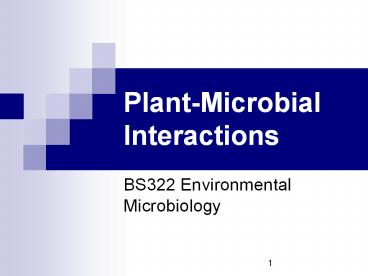PlantMicrobial Interactions - PowerPoint PPT Presentation
1 / 16
Title:
PlantMicrobial Interactions
Description:
Understand the general biology of agrobacterium and the diseases it causes ... T-DNA in agrobacterium showing the putative function of VirD1, VirD2, VirD3, ... – PowerPoint PPT presentation
Number of Views:192
Avg rating:3.0/5.0
Title: PlantMicrobial Interactions
1
Plant-Microbial Interactions
- BS322 Environmental Microbiology
2
Topics
- MECHANISM OF INFECTION OF PLANTS BY AGROBACTERIUM
- Bacillus thuringiensis (Bt) toxin
3
MECHANISM OF INFECTION OF PLANTS BY
AGROBACTERIUMLearning objectives
- By the end of this topic you should
- Understand the general biology of agrobacterium
and the diseases it causes - List the historical discoveries about
agrobacterium and how they led to knowledge about
its biology - Describe the functional structure of the Ti
plasmid - Discuss the molecular events that lead to
agrobacterium infection and disease development - Discuss the biological control of agrobacterium
- Know where to find further information about this
topic!
4
MECHANISM OF INFECTION OF PLANTS BY
AGROBACTERIUM
- References
- All PowerPoint presentations will be available
at - http//homepages.uel.ac.uk/J.Mottley
- The following should be on desk ref in Stratford
library sometime this week otherwise request a
look at my copies - Hooykaas, P.J.J. and Schilperoort, R.A. (1992).
Agrobacterium and plant genetic engineering.
Plant Molecular Biology 19, 15-38 - Kado, C.I.K. (1991). Molecular mechanisms of
crown gall tumorigenesis. Critical Reviews in
Plant Sciences 10, 1-32 - Tinland, B. (1996). The integration of T-DNA into
plant genomes. Trends in Plant Science 1, 178-184
(available from ScienceDirect)
5
Historical discoveries about agrobacterium
- Turn of 20th century found causes crown gall
disease - 1940s crown gall tissue cultured due to
hormone autotrophy - 1970s pathogenicity transferred between
bacteria via conjugation evidence of plasmid
involvement (see evidence next) - 1980s T-DNA was first engineered to carry useful
genes into plants using methods that hijacked
the natural process
6
Evidence for plasmid involvement in the virulence
of agrobacterium
- Relationship between virulence and specific
plasmids in different agrobacterium strains - Loss of virulence with loss of plasmids when
grown at high temp (plus restoration of virulence
when same plasmids replaced) - Virulence transferred when plasmids transferred
between virulent and non-virulent strains
7
- 4. Stable nature of hormone autotrophy in
infected host plant tissues indicated that this
was genetically determined and could result from
genetic transfers between agrobacterium and its
host - 5. Fragments of agrobacterium plasmids (T-DNA)
were found in the DNA of diseased tissues
Fig 1 Autoradiogram of a Southern blot of DNA
extracted from cured crown gall cells probed
with T-DNA showing the presence of T-DNA within
the plant genome. Lanes 1 2 T-DNA extracted
from agrobacterium Ti plasmid Lanes 3, 5 6
DNA extracted from gall cells Lane 4 DNA from
non-infected plant tissue
8
- 6. Plants regenerated from diseased tissues were
bred to produce offspring which inherited the
T-DNA in a Mendelian manner. - This indicated that the T-DNA was integrated into
nuclear DNA - The overall conclusion was that it was a natural
method for agrobacterium to genetically engineer
their hosts for their own benefit
9
Fig. 2 Genetic structure of the Ti plasmid
Oncogenes
TR
TL
Cyt
Aux
Opines
Genetic map of an octopine Ti plasmid
10
Fig. 3
11
Fig. 4 Activation of vir genes via vir A and vir G
12
(a)
Fig. 5 Model for the formation of
single-stranded T-DNA in agrobacterium showing
the putative function of VirD1, VirD2, VirD3,
VirE2 and the virB operon
13
Summary of the infection process
Fig. 6
14
Biological control of agrobacterium
- Uses K84 strain of A. radiobacter which kills
only certain strains of A. tumefaciens - Seeds, seedlings or cuttings of plants dipped
into suspensions of K84 immediately before
planting - Very successful and first biocontrol method used
against a bacterial plant pathogen. - Recently K84 has been genetically modified to
increase its persistence and the new strain K1026
is marketed as Nogall the first commercial
release of a GMM as a pesticide
15
How do K84 and K1026 work?
- Only works against strains of A. tumefaciens that
haveT-DNA that codes for agrocinopine - These strains have a corresponding
agrocinopine-catabolising genes on the non-T-DNA
section of their Ti plasmids - K84 and K1026 secrete an antibiotic chemical
analogue of agrocinopine called agrocin 84 - This is mistaken for agrocinopine by the A.
tumefaciens strains and is taken in and inhibits
nucleic acid metabolism - So is specific to those strains that catabolise
agrocinopine and no others
16
How do K84 and K1026 produce agrocin 84?
- the genes coding for the agrocin 84 are located
on a plasmid in these strains - the plasmid also contains genes which confer
resistance to the antibiotic - unfortunately, K84 also contains genes on its
plasmids that allow transfer of its plasmid to
other agrobacteria during conjugation. This
presents the danger that A. tumefaciens might
receive a plasmid and become resistant to agrocin
- to prevent this, the plasmid of the K1026 was
genetically engineered with the transfer genes
deleted. The K1026 strain is just as pathogenic
as K84 but there is no danger that it will pass
on its agrocin resistance to A. tumefaciens - also, K84 and K1026 have a second plasmid which
contain incompatibility genes that prevent these
strains from receiving a Ti plasmid and hence
becoming pathogenic (as well as them already
being resistance to agrocin)































